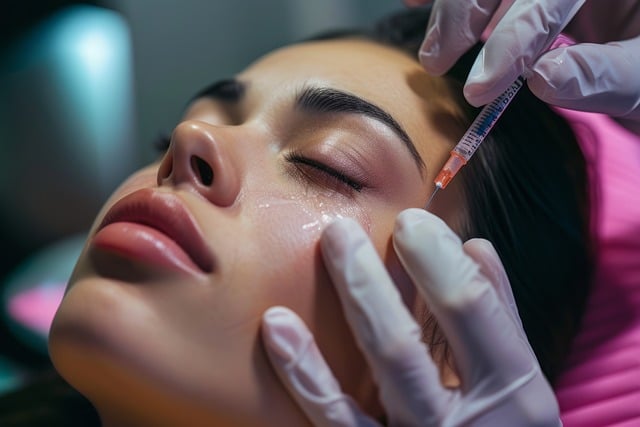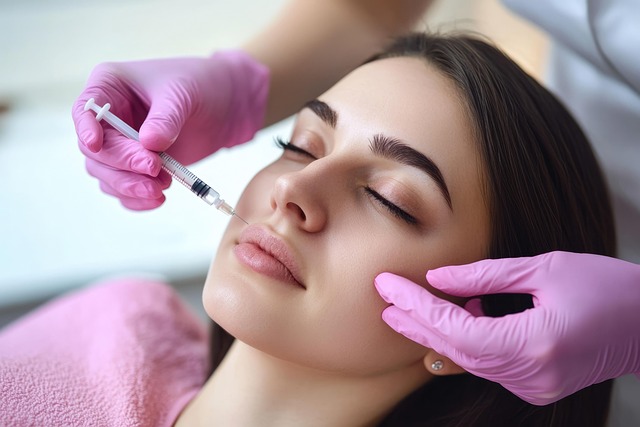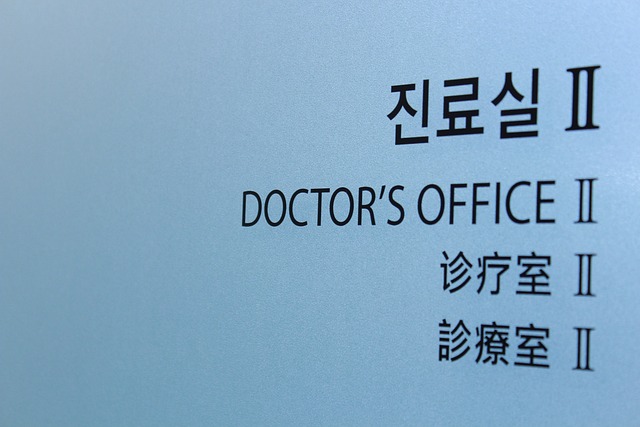Botox treatments, using botulinum toxin, are popular non-surgical cosmetic procedures that temporarily paralyze muscles to reduce wrinkles. Administered by certified professionals through precise injections, these treatments offer minimal downtime and results lasting 3-6 months. Beyond aesthetics, Botox can alleviate medical conditions like excessive sweating and migraines. Safety is paramount; following post-care instructions minimizes potential side effects. Qualified providers with extensive experience ensure optimal results while managing risks associated with Botox treatments.
“Discover the transformative power of non-surgical Botox treatments, a popular aesthetic choice for those seeking youthful radiance without invasive procedures. This comprehensive guide explores the intricate world of Botox, from its mechanism of action to the diverse areas it can target. Learn how this treatment works, its numerous benefits, and the step-by-step process involved.
We’ll delve into safety considerations, common application zones, recovery, and side effects management, empowering you to make informed decisions when choosing a qualified provider for your Botox journey.”
Understanding Non-Surgical Botox: A Comprehensive Overview

Non-surgical Botox treatments have gained immense popularity as a cosmetic procedure, offering a way to achieve a youthful appearance without the need for invasive surgeries. This minimally invasive approach utilizes botulinum toxin, commonly known as Botox, to temporarily paralyze muscles and reduce the appearance of wrinkles. It’s important to understand that while “non-surgical” implies minimal intrusion, it still requires expert administration and involves precise injections into specific muscle groups.
Botox treatments work by blocking nerve signals that cause muscle contraction, which is a primary contributor to wrinkle formation. Through this process, it can smooth out fine lines and wrinkles around the eyes, forehead, and other areas, providing a more relaxed and rejuvenated look. The procedure is often sought after for its ability to offer noticeable results with minimal downtime, making it an attractive alternative to traditional cosmetic surgeries.
How Do Non-Surgical Botox Treatments Work?

Non-surgical Botox treatments have gained popularity as a minimally invasive approach to anti-aging and cosmetic enhancements. The process involves injecting a small amount of botulinum toxin (Botox) into specific muscles, which temporarily paralyzes them. This action reduces the appearance of fine lines and wrinkles by preventing muscle contractions that cause dynamic wrinkling. By relaxing these muscles, Botox treatments provide a smoother, more youthful complexion.
The effectiveness of non-surgical Botox treatments lies in its ability to target problem areas precisely. A trained professional injects the toxin into the desired muscles, focusing on areas like the forehead, eyes, and mouth. This localized treatment ensures minimal discomfort and side effects compared to surgical procedures. The results are usually noticeable within a few days, with the effects lasting for several months, offering a temporary yet significant improvement in skin appearance and texture.
Benefits and Advantages for Patients

Non-surgical Botox treatments offer a multitude of benefits and advantages for patients seeking aesthetic improvements or medical relief. One of the primary advantages is their non-invasive nature, eliminating the need for incisions, anaesthesia, and recovery periods associated with traditional surgical procedures. This makes Botox treatments an attractive option for those who desire subtle enhancements without undergoing extensive surgery.
Additionally, Botox treatments have been proven effective in reducing the appearance of fine lines and wrinkles, providing a more youthful complexion. They can also be used to treat medical conditions such as excessive sweating (hyperhidrosis) and chronic migraines. The non-permanent nature of Botox means results typically last between 3 to 6 months, allowing patients to maintain their desired look while enjoying the flexibility to adjust treatments as needed.
The Process: Step-by-Step Guide to the Procedure

The process of non-surgical Botox treatments involves several precise steps designed to deliver optimal results. First, a qualified healthcare professional will conduct a thorough consultation to assess your facial structure and identify areas suitable for Botox injections. This step is crucial as it ensures the treatment is tailored to your unique needs. During the actual procedure, sterile needles are used to inject small amounts of Botox into specific muscle groups, targeting lines and wrinkles.
The injections are typically administered in a quick, efficient manner, minimizing discomfort. After the treatment, mild redness or swelling may occur temporarily at the injection sites. Patients can return to their daily routines immediately, with no downtime required. This step-by-step approach ensures a safe and effective Botox treatment experience.
Safety and Efficacy Considerations

When considering non-surgical Botox treatments, it’s crucial to understand safety and efficacy considerations. Botox, a neurotoxin derived from bacteria, is widely used for its ability to temporarily relax muscles and reduce wrinkles. However, as with any cosmetic procedure, there are potential risks involved. Unqualified practitioners or incorrect administration can lead to unwanted side effects such as bruising, swelling, or asymmetry in facial expressions.
To ensure the best outcomes, it’s essential to seek treatments from certified professionals who have extensive experience with Botox injections. Regular monitoring and follow-up sessions are also important to adjust dosages and manage any adverse reactions promptly. With proper care and expertise, Botox treatments can offer significant improvements in appearance without the need for surgery, making them a popular choice for many individuals seeking non-invasive cosmetic enhancements.
Common Areas Treated with Non-Surgical Botox

Non-surgical Botox treatments have gained significant popularity due to their ability to offer a variety of benefits without the need for invasive procedures. The most common areas treated with non-surgical Botox include facial lines and wrinkles, especially around the eyes (crows’ feet), forehead, and neck. These areas are particularly susceptible to dynamic lines caused by muscle movement, making them ideal candidates for Botox injections.
Additionally, non-surgical Botox treatments can be used to enhance specific features or reduce the appearance of age-related volume loss. The jawline, cheeks, and brow bones are examples where Botox can be injected to define facial contours, providing a more balanced and youthful look. In recent years, there has been an increase in the use of Botox for medical purposes as well, such as treating excessive sweating (hyperhidrosis) and chronic migraine headaches.
Recovery and Post-Treatment Care

After a non-surgical Botox treatment, it’s important to allow sufficient time for recovery and to follow post-treatment care instructions diligently. The effects of Botox typically start to appear within a few days, reaching their peak at around 2-4 weeks after the procedure. During this period, it’s crucial to protect the treated areas from excessive sun exposure and avoid strenuous activities that could increase blood flow to those sites, as this may dilute the results.
Post-treatment care involves keeping the treated area clean and moisturized, avoiding makeup or other products for a few days, and refraining from massaging or touching the site. Some mild swelling, bruising, or redness is normal and should subside within a week or so. If any adverse reactions persist or worsen, it’s essential to contact your healthcare provider promptly. Following these simple steps will ensure optimal results and help minimize potential side effects of Botox treatments.
Potential Side Effects and Management

Non-surgical Botox treatments, though generally safe, can have potential side effects. Temporary redness, swelling, or discomfort at the injection sites are common, usually resolving within a few days. Headaches, muscle weakness, and difficulty swallowing may occur but are rare and typically mild. To manage these side effects, patients should avoid strenuous activities for a day, apply ice packs to reduce swelling, and rest. Over-the-counter pain relievers can alleviate discomfort. It’s crucial to discuss any concerns or history of allergies with your provider before treatment to ensure the best experience.
While Botox treatments offer significant aesthetic benefits, it’s essential to be aware of potential risks. Serious side effects are rare but may include asymmetry, muscle weakness leading to difficulty in facial expression, and in very rare cases, allergic reactions. Promptly contacting your healthcare provider is advised if you experience persistent or severe symptoms. Regular follow-ups with a qualified practitioner can help mitigate risks and ensure optimal results, allowing patients to enjoy the benefits of enhanced appearance without significant drawbacks.
Choosing a Qualified Provider for Your Botox Treatment

When considering non-surgical Botox treatments, choosing a qualified provider is paramount for achieving optimal results and ensuring your safety. Look for licensed dermatologists or plastic surgeons with extensive experience in Botox administration. Reputable professionals will have completed advanced training and maintained current certifications, signifying their proficiency in this aesthetic procedure.
Reputations matter; seek recommendations from friends or consult patient reviews to gauge a provider’s skill and bedside manner. A qualified practitioner will take the time to understand your goals, discuss expectations, and tailor the treatment plan accordingly. They’ll also thoroughly assess your medical history to mitigate potential risks, ensuring a safe and effective Botox experience.
